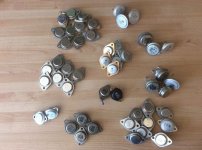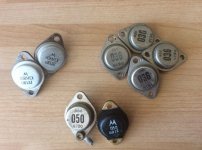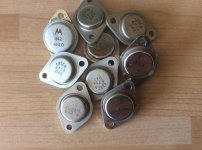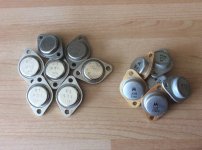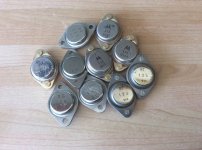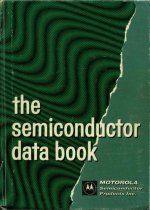I recently acquired a ot of transistors mainly TO3 case but also some "flying saucer" ones.
They have strange numbers, probably house codes.
Can anyone shed some light on what they are?
Thanks.
Andy
They have strange numbers, probably house codes.
Can anyone shed some light on what they are?
Thanks.
Andy
Attachments
Looks like Germaniums, some are Motorola 🙂
You can download + 1500 pages datasheet catalogue from this page
motorola :: dataBooks :: 1966 Motorola Semiconductor Handbook 2ed Aug66 :
Free Download, Borrow, and Streaming : Internet Archive
You can download + 1500 pages datasheet catalogue from this page
motorola :: dataBooks :: 1966 Motorola Semiconductor Handbook 2ed Aug66 :
Free Download, Borrow, and Streaming : Internet Archive
Attachments
Wow!!!
You got the De Lorean time machine car working!!!! 😀
Incredible find.
Start by measuring Vbe and Vcb to check/confirm they are Silicon or Germanium, polarity, and also diode check Vce to confirm they are not straight shorted.
Some might be bad, many (all?) look like "pulls".
Can´t even imagine who had all those stashed for so many years.
PS: that Motorola databook looks like some serious stuff, good find.
Only problem now lies in finding some use for them. 😛
Maybe you need a solid state vibrator to power your Motorola tubed car radio? 😱
The first SS power amp I ever built, in the mid 60´s, was the power section of a car radio, single ended Class A (of course), a single TO3 Germanium , must have been Philips or Siemens made because we are more European than US influenced, claimed 2W RMS out , it used a choke load or OT, fuzzy memories but definitely some iron was involved, and pulled constant 1A no matter what.
No big deal for a car battery but taxing the "battery eliminator" I had kludged.
You got the De Lorean time machine car working!!!! 😀
Incredible find.
Start by measuring Vbe and Vcb to check/confirm they are Silicon or Germanium, polarity, and also diode check Vce to confirm they are not straight shorted.
Some might be bad, many (all?) look like "pulls".
Can´t even imagine who had all those stashed for so many years.
PS: that Motorola databook looks like some serious stuff, good find.
Only problem now lies in finding some use for them. 😛
Maybe you need a solid state vibrator to power your Motorola tubed car radio? 😱
The first SS power amp I ever built, in the mid 60´s, was the power section of a car radio, single ended Class A (of course), a single TO3 Germanium , must have been Philips or Siemens made because we are more European than US influenced, claimed 2W RMS out , it used a choke load or OT, fuzzy memories but definitely some iron was involved, and pulled constant 1A no matter what.
No big deal for a car battery but taxing the "battery eliminator" I had kludged.
Thanks for the replies.
I was hoping to build something along the lines of the following thread:-
Germanium investigations
The first amp I built was a 2 transistor class A amp from an old manual by Barnards.
Andy
.
I was hoping to build something along the lines of the following thread:-
Germanium investigations
The first amp I built was a 2 transistor class A amp from an old manual by Barnards.
Andy
.
Some of them look like they have been pulled from IBM SMS modules.
Thus, germanium and house numbers. It will be difficult to find their characteristics.
Thus, germanium and house numbers. It will be difficult to find their characteristics.
You can go vaguely by production date. After figuring out ge versus si, PNP vs NPN, what was selling in big numbers in 1973? 1975? The date code is right on there. That gives you an upper limit on current limit, Vce, intended use current. Before soa was invented, you used a power transistor at the current before the gain dropped down to 5 or 2. Mid sixties designers actually went down to gain 5 a lot.It will be difficult to find their characteristics.
You can test Vceo with a 30 v supply, or more, a 47k resistor and a microammeter. Ice 2 uA, you under the Vceo. Current= supplyvoltage/47k, you're over the Vceo.
Don't use 2 hands to probe or apply voltages over 24, current across your heart can stop it. No jewelry on hands wrists or neck.
Last edited:
- Home
- Design & Build
- Parts
- Help Identify These Transistors
